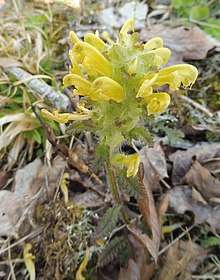Pedicularis canadensis
| Pedicularis canadensis | |
|---|---|
 | |
| Scientific classification | |
| Kingdom: | Plantae |
| (unranked): | Angiosperms |
| (unranked): | Eudicots |
| (unranked): | Asterids |
| Order: | Lamiales |
| Family: | Orobanchaceae |
| Genus: | Pedicularis |
| Species: | P. canadensis |
| Binomial name | |
| Pedicularis canadensis | |
Pedicularis canadensis, commonly called Canadian lousewort[1] or wood betony,[2] is a flowering plant in the broomrape family (Orobanchaceae).[3]. It is native to North America, where it is widespread in southeastern Canada and the eastern United States.[4] It has a wide-ranging natural habitat, being found in mesic to dry, forests, woodlands, and prairies.[5][6]
Description
Pedicularis canadensis is a herbaceous clonal perennial, growing to 30 cm tall.[6] It has long, soft, hairy leaves (many are basal, growing tufted from roots), some 5 to 15 inches long, deeply incised and toothed, often reddish-purple under sunlight. Blooming time is from spring to summer. It produces a broad whorl of tubular, hooded flowers on top of a segmented stalk. The flowers range in color from a greenish-yellow to purplish-red, clustered on short, dense spikes. They are pollinated by bumblebees. The fruit is a long brown seed capsule, which disperses through explosive dehiscence.[2]
Pedicularis canadensis is a parasite, attaching to the roots of diverse species.[7] Its roots also have a symbiotic relationship with a fungus that helps it gather nutrients.[8]
Uses
This plant was eaten by the Iroquois as a vegetable, often as a soup. It was added to oats and used as horse feed by Native Americans.
American Indians used a root infusion as a remedy for stomachaches, diarrhea, anemia and heart trouble and made a poultice for swellings, tumors and sore muscles.[9]
Folklore
The Menomini called the root "enticer root" and carried it as a charm when determined on seducing the opposite sex. The root was also used to heal broken marriages by placing it in food the couple would both eat, hoping its magic would rekindle romance.
References
- ↑ "Pedicularis canadensis". Natural Resources Conservation Service PLANTS Database. USDA. Retrieved 20 August 2018.
- 1 2 Wood Betony (Pedicularis canadensis) U.S. Forest Service
- ↑ Stevens, P.F. (2001–2012), Angiosperm Phylogeny Website: Orobanchaceae
- ↑ "Pedicularis canadensis". County-level distribution map from the North American Plant Atlas (NAPA). Biota of North America Program (BONAP). 2014. Retrieved 20 August 2018.
- ↑ Alan Weakley (2015). "Flora of the Southern and Mid-Atlantic States".
- 1 2 Yatskievych, George (2013). Flora of Missouri, Volume 3. Missouri Botanical Garden Press. p. 580.
- ↑ Gracie, Carol (2012). Spring Wildflowers of the Northeast. Princeton University Press. pp. 126–131. ISBN 978-0-691-14466-5.
- ↑ Horn, compiled and edited by Dennis Horn and Tavia Cathcart ; technical editor, Thomas E. Hemmerly ; photo editors, David Duhl and Dennis (2005). Wildflowers of Tennessee, the Ohio Valley, and the Southern Appalachians : the official field guide of the Tennessee Native Plant Society. [Edmonton]: Lone Pine Pub. p. 288. ISBN 978-1-55105-428-5.
- ↑ Foster, Steven; Duke, James A. (1990). A Field Guide to Medicinal Plants and Herbs of Eastern and Central North America. United States of America: Houghton Mifflin. p. 106. ISBN 0-395-46722-5.
External links
- Connecticut Plants, Connecticut Botanical Society